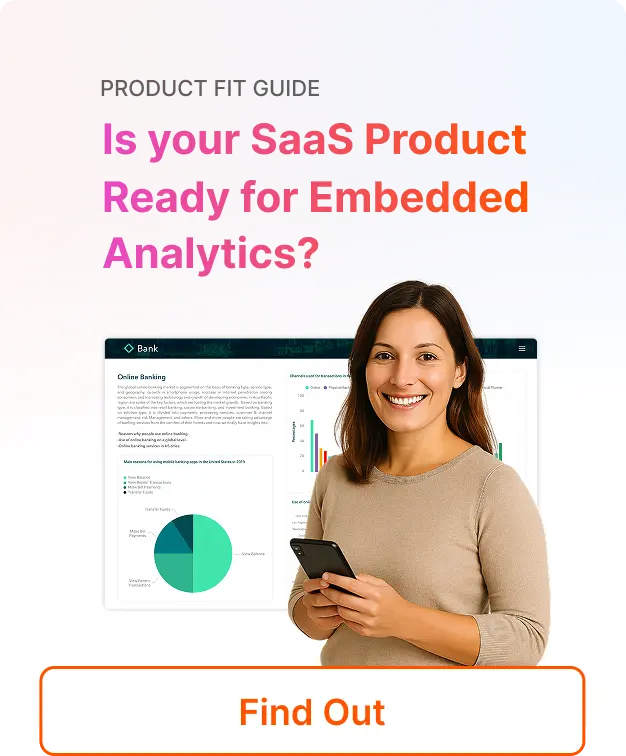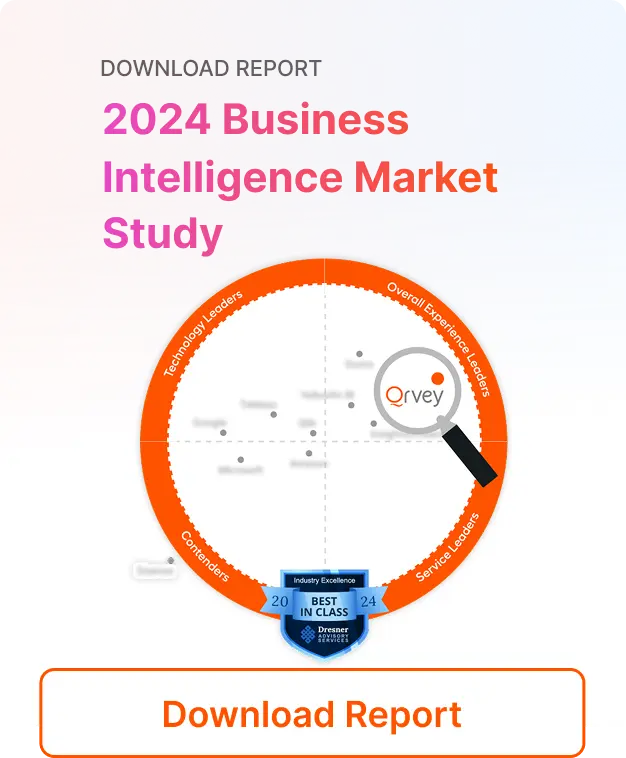Find new developers. Meet dev milestones to maintain roadmap progress. Demo to prospects to help close new deals. The SaaS business is never simple or easy. New challenges pop up regularly, while old ones persist, like fixing bugs and reducing customer churn.
But analytics doesn’t have to be another pain point, or even something that devours time in your development lifecycle. If your team is grappling with trying to build product analytics in house, or worse, not having analytics at all because it’s all just too much, the solution is embedded analytics.
As an easy-to-implement self service solution, embedded analytics exist to make everything easier, less time-consuming, less costly, and more secure.The benefits of embedded analytics are extensive, particularly when leveraging a third-party app. Read on for the top ten reasons embedded analytics can transform your SaaS product, plus a bonus benefit #11.
What is Embedded Analytics?
Embedded analytics is the technological capability to include analytics features and functions as an inherent part of another application.
When analytics are embedded in a SaaS app, users can analyze the data they create inside that app without needing to export data and import it into a separate business intelligence tool.
Benefit #1: Increase Revenue & Gain New Monetization Options
You can benefit from embedded analytics by monetizing the functionality through various packaging and pricing strategies. Software monetization is defined as the various actions a software provider takes to extract value from their IP and maximize profitability.
Paddle, provider of payments infrastructure for SaaS companies, conducted a study of 512 SaaS companies showing monetization was four times more efficient than acquisition in improving growth and twice as efficient than efforts to improve retention.
With embedded analytics, you can expand the scope of functionality delivered to users and raise the base price accordingly. You can also offer the new components as an option add-on for an additional fee, letting customers choose to purchase new functionality à la carte.
“Every hour you dedicate to building analytics means less time for other roadmap items.”
If you choose not to charge extra now, that doesn’t mean you can’t do so in the future.
With the right SaaS analytics platform, you can easily add value to command higher prices for advanced tiers.
Benefit #2: Increase Competitiveness with Data Visualizations
By embedding analytics, you can offer value that’s superior to your competition, increasing win rates. Embedded analytics solutions can be a powerful differentiator.
Data visualizations, including dashboards and reports, add value by helping organizations achieve numerous productivity gains.
Offering better BI insights with functionality such as self-service analytics, advanced analysis, and workflows can enhance the value of your app, empowering workers to make more intelligent decisions.
Empowering users to create stunning and interactive visualizations is one more way that embedded analytics can increase competitiveness.
Data visualization is the representation of data in a visual or graphical format, such as charts, graphs, maps, and infographics. These elements allow you to communicate complex information in a clear, concise, and visually appealing way.
Data visualizations can help your users bring their numbers to life and spot patterns, trends, and correlations that might not be immediately apparent in raw data.
Benefit #3: Free Up Developers to Focus on Your Core Roadmap
Budget, time, and staff are all finite.
There are only so many hours in the day and every hour you dedicate to building analytics means less time for other roadmap items.
By embedding third-party analytics, your developers can remain focused on the components that make up your core functionality and market requirements.
Product managers know that multi-tenancy is more cost-efficient, scalable, and easier to manage than a single-tenant SaaS model. But embedding analytics in multi-tenant apps adds several hurdles not found with organizations using analytics strictly internally. Data security with multi-tenant apps is a particular challenge.
Fortunately, it is possible to embed analytics while maintaining data security and scalability. The solution is for your embedded analytics solution to inherit your security model.
Qrvey is the only purpose-built solution for multi-tenant analytics. As a self-hosted solution, your data never leaves your control; your analytics run entirely inside your environment, inheriting your security policies, which is ideal for data security and governance.
Benefit #4: Meet Current & Future Customer Requests
Customers have high expectations, and if your product doesn’t meet those demands, your competitors likely will.
Embedded analytics can help SaaS companies deliver a better user experience and improve customer satisfaction.
In particular, self-service analytics make data exploration easy within SaaS apps, helping customers gain transparency into key metrics, trends, and insights that impact their goals.
This empowers them to quickly answer questions, monitor progress, discover optimization opportunities, and solve problems independently.
“Building analytics in-house means you’re committing to maintaining it in-house as well…”
Customers also expect every application they use to evolve and improve over time, and analytics is no exception.
Feature requests can be endless and run the risk of overwhelming your roadmap. But with embedded analytics, you can keep up with emerging trends in SaaS Analytics such as AI-powered insights, real-time analytics, and the expansion of self-service.
Benefit #5: Accelerate Development Time
Nearly every SaaS app has some type of important data that your users will want to analyze.
SaaS companies are challenged by continually growing customer demands for reporting and analytics features. Meanwhile, developers, data engineers, and software engineers are all in short supply.
According to IDC, a shortage of IT skills will impact nine out of ten organizations by 2026, with a cost of $5.5 trillion in delays, quality issues, and revenue loss.
Building in-house to deliver insights requires building out a data pipeline that allows for data ingestion, transformation, and visualization, which takes a considerable investment in developers’ time. Analytics delivery models like AaaS can help sidestep this entirely..
On the other hand, embedded analytics deliver the entire data workflow leveraging APIs to connect systems, automation to transform data, and visualizations to render output to end users.
While embedding analytics does require some development effort, the embedding process can be completed in a tiny fraction of the time required to build everything from scratch. Compressing this timeline delivers faster time to value while reducing development costs.
Benefit #6: Empower Users with Self-Service Analytics
Users often have very specific analytical requirements.
If your product can’t meet those needs both quickly and easily, many users would rather just export their data and work with it in another tool like Excel. And once they’ve left your app, you lose considerable perceived value and branding associated with your app.
OTOH, self-service analytics can deliver additional value, further boosting competitiveness, customer satisfaction, and retention. Self-service analytics enable end users to create their own charts and dashboards, adjust the parameters of existing ones, and even employ their own data in their creation.
With an effective and well-designed self-service interface, you can empower users to add custom enrichments to their data, such as building custom formulas or data visualizations, or creating their own unique dashboards and reports on the fly.
The self-service analytics experience should also meet the needs of different user roles and skill sets.
A complete self-service analytics experience results in users interacting with the data inside your system in a more meaningful way, deriving the highest value from your product.
Benefit #7: Minimal Ongoing Maintenance Efforts
Building analytics in-house means you’re committing to maintaining it in-house as well, a burden that’s often forgotten in the excitement of launching a new app. Ongoing maintenance of your homegrown SaaS analytics components entails more than just fixes, and includes the entire lifecycle of a module:
- Planning and roadmap processes
- Product management
- Non-engineering decision making
Using a third-party solution can substantially reduce these burdens and their associated costs.
Benefit #8: Boost Stickiness and Retention
Embedded analytics not only reduce churn but also keep each user within your product for longer, increasing engagement.
This reduces the risk that users will download data from your app to analyze it elsewhere. When you empower users to create their own dashboards and reports, they can build their own value and gain a sense of ownership, making your app stickier.
Enterprises analytics have the power to turn mountains of data into actionable insights, enabling data-driven decisions that lead to greater efficiency and productivity.
Particularly for large enterprises, small, incremental changes can have huge impacts, enabling your users to earn a substantial ROI, further boosting your retention rates.
Benefit #9: Predictable Costs and Reduced Risk
Calculating ROI is often difficult. For SaaS providers, it can be especially challenging to assign a price tag to the development efforts for each individual app component.
But third-party development platforms provide reliable cost projections. Vendasta, provider of digital marketing solutions, lists many pros of selling white-label products and services, including, “Developing proprietary solutions carries inherent risks. White-label products mitigate these risks by offering proven, ready-to-deploy solutions, minimizing the uncertainties associated with custom development.”
Benefit #10: Maintain Brand Identity
White-label analytics refers to embedded analytics software that can be rebranded and customized to blend in seamlessly with the parent application.
When you white-label embedded analytics, you make your charts, reports, and dashboards look like a seamless part of your software, instead of a third-party plugin.
White labeling offers better usability, helping to increase adoption. With proper white labeling, you can deliver all the functionality of self-service analytics tools in a high-quality experience that fits your brand. The benefits of white label analytics include:
- Maintain brand
- Consistent UX without added development
- Seamless integration
BONUS! Benefit #11: Build Without Subject Matter Expertise
You already have a team of developers who know UI/UX, AppSec, and more, but do they know analytics?
It’s a complex and far-ranging discipline, and all of the requisite skills can be hard to find.
Moreover, should you have turnover in your team, you may find it difficult to replace that relatively rare talent. In fact, a shortage of data and analytics skills is cited by Gartner as one of the “5 Pitfalls When Building Data and Analytics Teams.”
With a well-designed embedded analytics solution, you can even empower your users to extract useful insights from data without needing human involvement by providing automated analytics.
Embedded Analytics Challenges
Challenge #1: Inability to White Label
When you white label your embedded analytics, you make your charts, reports, and dashboards look like a seamless part of your software, instead of a third-party plugin.
White labeling, also often referred to as “customization,” increases user adoption and ease of use.
Unfortunately, white labeling is a significant challenge with many traditional BI tools. Embedded capabilities must be able to also maintain that same look and feel that your team built without having to rebuild significant components of the third-party analytics app.
Challenge #2: iFrame Embeds
Many traditional BI tools rely on iFrames for their embeds. Most infosec teams struggle to approve iFrame-based solutions due to security concerns. Implementing best practices for securing iFrame content can mitigate some risks, but challenges still remain. Others that do support JavaScript widgets may lack customization options. And some vendors will offer a combination of JavaScript and iFrame based widgets, further complicating integration into a SaaS application. Javascript-based widgets are the preferred method.
Challenge #3: Embedding Analytics in Multi-Tenant Apps
Embedding analytics in multi-tenant apps adds several hurdles not found with organizations using analytics strictly internally. Data security with multi-tenant apps is a particular challenge. It’s vital to prevent data leakage across tenants and ensure that within each tenant, users see only the data sets they’re authorized to see. Fortunately, it is possible to embed analytics while maintaining data security and scalability when your solution inherits your security model.
Additionally, embedded multi-tenant analytics often have unpredictable traffic patterns, so SaaS providers must ensure the data system can handle various tenant needs and high data volumes efficiently. Look for features like the right deployment models to support scalability and performance.
Challenge #4: Server Fees & User-Based Licensing
Some traditional BI solutions that began with a dependence on server installations may still require licensing for each server their software is installed on. Trying to integrate with a software development process or scale a cluster becomes cost-prohibitive over time.
Additionally, user-based licensing is a significant cost driver and often an underappreciated cost over time. Companies that try to “start small” rarely realize the ROI of their investment.
FAQ about Embedded Analytics
Why use embedded analytics?
Your app generates data that your users care about. Embedding analytics lets them get vital insights right within your app, making your app stickier and increasing the value delivered. Embedding third-party analytics alleviates the need to build and maintain in-house, so your team can stay focused on your core value prop.
What are the risks of embedded analytics solutions?
When embedding analytics, some common pitfalls and risks include data access and synchronization. Your app likely uses more than one type of data, so your analytics solution must be able to work with any type of data and to handle the complexity of combining multiple sources.
Forcing data transfer to a third-party cloud is another common risk. An ideal solution keeps your data right where it is – in your environment under your control.
Embedded analytics solutions that don’t scale easily or natively often create a bottleneck that becomes expensive to fix. Ideally, you should be able to scale without a costly, time-consuming rebuild. As your app scales, the increase in costs should be commensurate with the growth.
Let Qrvey Handle the Heavy Lifting
From increasing revenue, competitiveness, and retention, to freeing up developers and maintaining brand identity, the benefits of embedded analytics are so numerous, we were unable to contain them within 10 items.
If you’re ready to accelerate development time to empowering users with self-service analytics, get in touch with QRvey. Our embedded analytics platform is built to scale, packed with features, and ready when you are. Learn more today.

David is the Chief Technology Officer at Qrvey, the leading provider of embedded analytics software for B2B SaaS companies. With extensive experience in software development and a passion for innovation, David plays a pivotal role in helping companies successfully transition from traditional reporting features to highly customizable analytics experiences that delight SaaS end-users.
Drawing from his deep technical expertise and industry insights, David leads Qrvey’s engineering team in developing cutting-edge analytics solutions that empower product teams to seamlessly integrate robust data visualizations and interactive dashboards into their applications. His commitment to staying ahead of the curve ensures that Qrvey’s platform continuously evolves to meet the ever-changing needs of the SaaS industry.
David shares his wealth of knowledge and best practices on topics related to embedded analytics, data visualization, and the technical considerations involved in building data-driven SaaS products.
Popular Posts
Why is Multi-Tenant Analytics So Hard?
BLOG
Creating performant, secure, and scalable multi-tenant analytics requires overcoming steep engineering challenges that stretch the limits of...
How We Define Embedded Analytics
BLOG
Embedded analytics comes in many forms, but at Qrvey we focus exclusively on embedded analytics for SaaS applications. Discover the differences here...
White Labeling Your Analytics for Success
BLOG
When using third party analytics software you want it to blend in seamlessly to your application. Learn more on how and why this is important for user experience.








